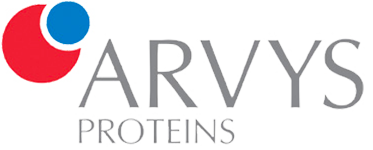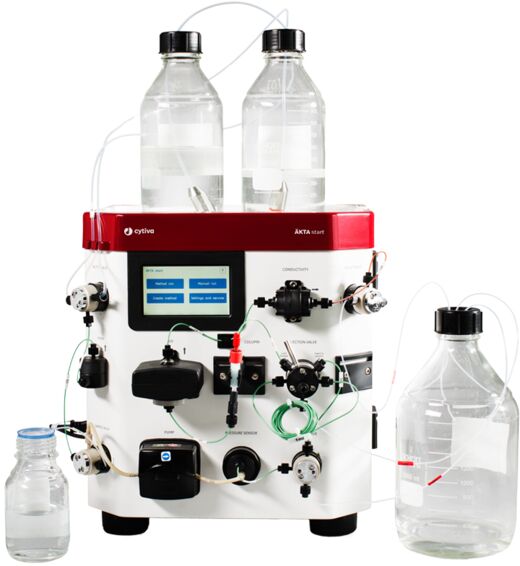ӒKTA Protein Purification Systems
The popularization of methods to obtain large quantities of proteins, peptides, and other large biomolecules has led to the advent of fast protein liquid chromatography (also known as fast-performance liquid chromatography or medium pressure liquid chromatography). FPLC utilizes a peristaltic pump to accurately control the speed at which the protein sample (mobile phase) passes through the chromatography column of choice (solid phase). Unlike other chromatography techniques like high-pressure liquid chromatography (HPLC), FPLC operates at a much lower pressure, ensuring that protein structure is not disrupted during purification. While many FPLC systems have been introduced since the technique’s introduction in the early 1980s, many research labs today utilize protein purification systems. ӒKTA models combine all components of a typical FPLC workflow (pump, pressure/UV sensors, fraction collector, etc.) into an automated, modular system compatible with most types of chromatography columns. The versatility and user-friendliness of these systems make them the workhorses of protein research in academic and industrial labs alike. For those seeking to switch from manual protein purification to an automated system like an ӒKTA, attempting to determine which of the many models currently available, and those that have come and gone, are right for you can be a daunting task. In this article, the differences between the four state-of-the-art ӒKTA systems will be compared to allow consumers to make the most informed decision as to which system is ideal for their lab. These systems are the ӒKTA start, ӒKTA go, ӒKTA pure, and ӒKTA avant. While other ӒKTA models have existed (notably the ӒKTA explorer and the ӒKTA purifier), these have been discontinued and are not readily available anymore. Thus, this article will focus on the four models that are still supported.
ӒKTA Start

ӒKTA Start
While at the lowest end of the available systems, the ӒKTA Start remains a desirable choice for those still on the fence about switching to an FPLC vs. traditional manual gravity-flow columns. The ӒKTA start may lack some of the bells and whistles of the higher-end systems, but affinity chromatography, ion-exchange chromatography, hydrophobic interaction chromatography, and multimodal (mixed mode) chromatography can still be fully automated with this system. Size exclusion chromatography is doable as well, but due to the flow rate and pressure limitations (0.5 to 5.0 mL/min and 0.5 MPa, respectively), not all size exclusion columns are compatible with the ӒKTA start. Thus, for a lab that relies heavily on size exclusion chromatography, a higher-end ӒKTA with a wider range of available operating conditions would be more suitable. Regardless, the wide variety of applications makes the ӒKTA start ideal for most low-scale purifications.
ӒKTA Go

ӒKTA Go
Those who rely heavily on techniques like size exclusion chromatography or who would like more options in their setup than the ӒKTA start can offer should consider the ӒKTA Go. The ӒKTA go features a greatly enhanced flow rate (0.01 to 25 mL/min) and pressure tolerance (up to 5 MPa) which removes the limitations on size exclusion imposed by ӒKTA start. The ӒKTA go also features a modular fraction collection attachment, which in addition to normal fraction tubes can also accommodate deep-well plates, microplates, or small fraction tubes. This fraction collection attachment can also be set up underneath the system itself, which reduces the overall footprint of the system and saves on valuable bench space. An optional pH meter can be installed onto this system to track the pH of eluted fractions in addition to UV and conductivity readouts.
ӒKTA Pure

ӒKTA Pure
The ӒKTA Pure may be very similar to the ӒKTA go in terms of technical specifications and capabilities but offers much more in terms of customizability. The ӒKTA pure is offered in a variety of models, the two main categories of which are the ӒKTA pure 25 and the ӒKTA pure 150, the latter of which boasts a staggering 150 mL/min maximum flow rate for immensely scaled up protein purifications. Multiple columns can be hooked up to the ӒKTA pure simultaneously and can be automatically switched between using more advanced purification programs that this system is capable of. Much like the ӒKTA go, this automation is extended to the optional fraction collection system, which can accommodate deep-well plates, microplates, or small fraction tubes in addition to normal fraction tubes. More advanced features like resin scouting, pH monitoring, air sensors, etc. come in the form of optional upgrades that can augment the ӒKTA pure’s modular design with ease. These upgrades, in addition to the two base models, make the ӒKTA pure the most versatile among the available ӒKTA systems as it can be tailor-made to suit each individual’s needs.
ӒKTA Avant

ӒKTA Avant
The Avant is the highest end of all available ӒKTA systems, integrating many of the optional upgrades of the ӒKTA pure as standard features. These include pH monitoring, multi-wavelength detection, air sensors, and extended buffer inlets (18 inlets standard, option to upgrade further to 46). The ӒKTA Avant also has a couple of features that are exclusive to this higher-end system. The first is a fully integrated fraction collection system, which is enclosed and refrigerated, keeping protein fractions stable for long periods. The second is a buffer mixing system that utilizes the Avant’s numerous inlets to create column buffers automatically. This system is ideal for testing a variety of conditions for optimal protein purification, as opposed to making each buffer and testing them one at a time. The myriad of convenience and analytical tools that the ӒKTA Avant offers make it an ideal choice for those seeking to massively increase their throughput of protein purification or transition to higher scale preps.
Which One is Right For Me?
There are many different factors one should consider before purchasing an FPLC system like an ӒKTA. The first is how heavily your lab relies on protein purification services. For labs that seldom require producing their protein and have been running columns manually, a lower-end system like the ӒKTA start will likely suit their needs with its automation of many different types of chromatography. For labs that do purify proteins regularly and want to automate more advanced chromatography techniques like size exclusion, the ӒKTA go would be a good system to start with. If more advanced purification protocols with complex readouts are a common occurrence in your lab, a highly customizable system like the ӒKTA pure will satisfy all of those conditions while providing opportunities for future upgrades. For labs that purify proteins around the clock and need to scale up their workflow while increasing throughput, a high-end system like the ӒKTA Avant would be most ideal. While many intricate details of all ӒKTA systems have been omitted from this article for the sake of brevity, the general descriptions of the capabilities these systems offer should be sufficient to get prospective buyers looking in the right direction.




